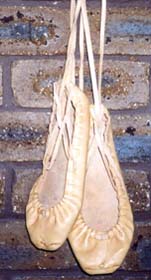Accessories
Both men and women carried handkerchiefs which were white, chequered or embroidered. Fancy mittens were common accessories for menís costumes, and often knitted by their brides. Socks were usually white, knee-high, woollen in winter and linen in summer, and could be plain or patterned. Early footwear were types of slippers woven from strips of willow bark tied with linen cord which was criss-crossed up the calf nearly knee-high (vizes). Later they were made from a single piece of sole leather (pastalas) until shoes and boots were made for men from black leather.

I got these pastalas in Latvia in 1991 and they fit perfectly.
Every district had its own traditional way of wearing the broaches (saktas) at the front of the blouse and at the neck opening, but their abundance reflected the wearerís wealth and status. Most jewellery was made of silver but sometimes plated with bronze or adorned with red or blue stones. Amber broaches, amber beads and double buttons were more characteristic of southern regions. The sun symbol in the designs of much of Latvian jewellery reflects the association between amber and the sun.
Latvian folk art is made up of geometric designs consisting of separate elements combined in a unified composition. Because the same word (raksts) is used for writing and these folk designs, it is possible that the intricate patterns are an ancient form of communication.